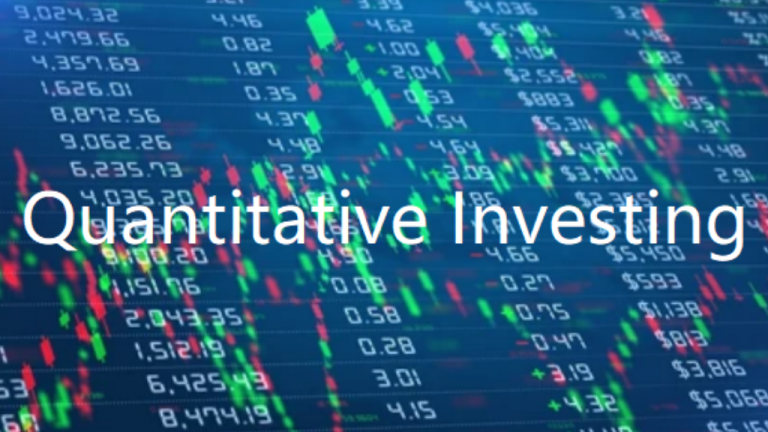Based on factual data, quantitative portfolio management reduces the detrimental impacts of emotion on decision making, is less expensive than fundamental analysis, and enables small teams to cover a vast universe of securities. Quantitative investing has yet to reach its full potential, with numerous significant developments in progress and on the horizon. This article provides an overview of quantitative investing. Quantitative investing is the application of quantitative market-beating strategies. It combines the skills of analysts, statisticians, and programmers to produce mathematical models that consume quantitative data from market feeds and other sources. A computer model designed to exploit inefficiencies analyzes the data. When the algorithm detects a good trend or identifies an inefficiency, the corresponding buys and sells are automatically triggered.
Table of Contents
The emergence of quantitative investing
Sam Eisenstadt laid the foundation for quantitative investing in 1965. He developed the first quantitative ranking system based on 6-month trailing performance and observed that the best-performing stocks outperformed the worst-performing stocks.
Currently, most of the investment community uses quantitative investment strategies, which are utilized by several funds and institutional investors to outperform stocks and boost returns. Let’s examine quantitative investing and why it has caught the interest of so many investors in further detail.
What is quantitative investing?
Quant investing is the practice of making investment decisions solely based on the suggestions of a computer algorithm that has been given enormous quantities of quantitative data and trained using machine learning. This means that strictly speaking, each investor is capable of constructing a personal portfolio using quantitative investing concepts. However, the phrase is mostly applied to “quant” hedge funds, which often have greater access to the technical know-how required to develop their own customized machine learning algorithms and feed them the necessary data. Sourcian is a dedicated platform for the recommendation of the best manufacturers. Your sourcing journey starts right here at sourcian.
Utilizing statistical and mathematical models, quantitative investment management examines the behavior of stocks and other asset types. Quantitative investing has two independent components: research and implementation. Research may be based on proprietary research or academic articles that have been published. The study is utilized to develop a model that finds stocks with an above-average likelihood of beating a benchmark index. Stocks are often awarded a score based on one or more qualities (or criteria) and then ranked in order to execute a model. Typically, a quantitative investing portfolio will consist of the highest-ranked stocks and will be rebalanced at regular intervals or when it deviates from a model. Both long-only and long/short portfolios may be managed with quantitative strategies.
Behind the Curtain of Quant Strategies
As in “The Wizard of Oz,” someone is driving the process from behind the curtain. As with any model, the software is only as good as the person who created it. While there is no precise criterion for becoming a quant, the majority of organizations that run quantitative models combine the talents of investment analysts, statisticians, and computer programmers. Due to the complexity of mathematical and statistical models, advanced degrees and doctorates in finance, economics, mathematics, and engineering are prevalent. Historically, these team members worked in the back office, but as the use of quantitative models increased, they migrated to the front office.
How are quantitative investing strategies implemented?
Before pursuing a trading hypothesis, designing and implementing a quantitative strategy requires extensive back-testing. The steps involved in developing a quantitative strategy include:
Finding anomalies or criteria that can be connected to outperformance or improved risk management by sifting through data.
Developing and back-testing the model. A back-test is a simulation that uses previous data to predict the future performance of a quantitative strategy or model. Using historical stock market prices over a five-year period, for instance, a back-test may determine if a model would have exceeded benchmarks or better-managed portfolio risk owing to market volatility.
Implement the strategy by utilizing predetermined rules to select assets and build the optimum portfolio. In addition, the model and portfolio maintenance and revision are required.
Types of quantitative investment strategies
The majority of quantitative strategies are said to be either relative value or directional. Using software and computer models to forecast future events using previous data is a characteristic shared by these strategies. Data-driven investing is another name for quantitative investing.
The objective of relative value quantitative strategies is to find and profit from price correlations. For instance, investors may employ a model that identifies a predicted link between the prices of short-term and long-term government bonds.
Directional strategies adhere to trends or other patterns that might indicate price rises or drops. Using quantitative data to identify past evidence to boost the future values of long-term government bonds, for instance.
Some common quantitative investment strategies:
The quantitative value strategy utilizes the entirety of the income statement and balance sheet. The model computes a weighted average score and ranks stocks;
Event-driven arbitrage refers to strategies examining event-related data, such as regulatory changes, company activities, etc. Purchasing and selling transactions occur if the model identifies a certain pattern in price fluctuations;
Risk parity funds relate to the idea that gains in one asset class compensate for losses in another. This strategy may boost long-term risk-adjusted returns;
Passive investors utilize smart beta strategies (e.g., mutual funds or ETFs) to enhance risk-adjusted returns by utilizing factors other than market capitalization.
Statistical arbitrage aims to find mispriced securities by analyzing their connection. This strategy often opens short and long trades based on financial ratios. It’s an example of an active trading strategy;
Initially, investors utilized managed futures strategies in futures markets to track the market’s major patterns. Currently, they are also increasingly prevalent on the stock markets;
Factor-investing strategies employ one or more factors that have historically outperformed a benchmark index. Examples include expansion, momentum, market capitalization, and value. The mathematical model assigns each stock a score based on these parameters and then uses the total score to rank the stocks;
Systematic global macro strategies attempt to discover strategies and places with positive fundamentals. In other words, the model allocates cash by assessing the economies of distinct global regions.
The most recent quant strategies are AI and big data strategies. Generally, AI investing includes employing alternative data. Additionally, it is vital to remember that research indicates machine-learning-based quantitative strategies are typically more effective than conventional quantitative investing.
Multi-asset strategies relate to the practice of mixing numerous types of assets into a single portfolio. The sorts of assets may include stocks, bonds, real estate, and cash.
The advantages of quantitative investing
Since a computer model determines quantitative trading choices, they are unaffected by human emotion. When making investment decisions, people are frequently motivated by fear or greed. This applies to both entering and leaving positions, where investors frequently lack discipline. Moreover, quantitative investing can really take advantage of illogical market decision-making.
Small teams of quantitative analysts are capable of covering a vast array of securities. They are able to cover numerous industries, locations, and nations without the need to engage additional analysts. Therefore, quantitative teams have a greater chance of locating equities that are likely to outperform. It also implies analysis is less expensive per stock.
Quantitative investing is evidence-based, making the outcomes more predictable, particularly regarding the predicted risk and return profile. Therefore, they may be better tailored to the demands of various investors. Once established, quantitative models may be evaluated in many markets quickly and affordably, with or without revisions.
Negative aspects of quantitative investing
Limitations of utilizing historical data
As with any other model or theory generated by humans, the quantitative investment strategy employed is only as effective as its creator. Long-Term Capital Management is a well-known example of a successful quant hedge fund during the 1990s.
The fund, led by Nobel laureates Robert C. Merton and Myron S. Scholes, gathered capital from all sorts of investors and generated additional profits by exploiting market inefficiencies. The used model does not account for the risk that the Russian government may default on its debt. As a result, its founders were forced to dissolve the company.
Since the quantitative hedge fund had extensive ties to global markets, its failure had significant repercussions. The Federal Reserve, other investment funds, and even banks needed to intervene to prevent the fund from inflicting further damage.
Quantitative funds
Due to their reliance on predicted returns and probability, quantitative strategies need a sizable portfolio. In addition, they require longer time periods to perform, and under shorter time constraints, they would likely underperform. This is not the case for all quantitative funds since other data sources are utilized to generate short-term alpha.
Sudden changes
There are instances or developments that only humans can identify, such as a company scandal or a shift in management. Nonetheless, you might create a mention tool in your system to monitor bad sentiment and give you data to detect some of the improvements.
However, if qualitative data is eventually included in AI models, these problems will no longer exist.
Why quantitative investing strategies?
When an active asset manager makes an investment choice, it is often based on their expectation of the business’s future success, with the belief that strong company performance would result in strong share price performance. These selections are based on subjective evaluations of the company’s management and goods, as well as its operating market and economic climate.
Since the 1960s, actively managed funds have been measured against indexes. Over time, it has been evident that the bulk of actively managed funds does not regularly exceed their respective benchmark indexes. In the early 1980s, for the first time, investment analysts were able to analyze very big data sets, thanks to technological advances in the 1970s. This quantitative study enabled investors to determine which sorts of stocks outperformed in the long run.
Three things were made feasible by quantitative investing: concurrently analysis of a larger number of stocks, judgments based on factual data as opposed to subjective projections, and a systematic approach to portfolio management. Earlier studies found that a number of anomalies existed to explain the behavior of stock prices. Value, momentum, and market value were revealed to be the top determinants of outperformance. Over time, more factors and factor combinations have been discovered to contribute to outperformance.
Also beneficial for asset allocation and risk management is quantitative investment analysis. It enables the construction or analysis of a portfolio based on predicted long-term returns and volatility. This allows investors to tailor their portfolios to their specific needs. Currently, the majority of funds adopt a quantitative approach for at least a portion of their portfolio management. Even if it is not employed for stock selection, it is typically employed for risk management and asset allocation.
Quantitative vs fundamental investing
Quantitative analysis is comparable to the conventional investment strategy of fundamental analysis. In fundamental analysis, investors focus on aspects that directly affect the value of underlying assets, such as profit margins, business health, assets held, and the quality and expertise of the management team.
The most renowned proponent of basic analysis is Warren Buffet. His strategy is to compare a stock’s fundamentals—performance, debt, and profit margins—against its price. If he believes that the stock’s fundamentals indicate that it is cheap, he invests for the long term.
The quantitative approach to investing is unique. Quants develop multi-factor models and employ them to examine many possible assets. The models range in complexity from those based on the ratios and correlations of a few well-understood metrics to those that employ hundreds of variables.
Quantitative analysis is the difficult art and science of determining which quantitative indicators to focus on and forecasting how their behavior influences the value and risk of an investment.
This “scientific” technique seeks to achieve the same results as fundamental research by discovering and capitalizing on market inefficiencies. However, rather than focusing on a small number of companies, it analyzes the behavior of important components to find market inefficiencies, which it then exploits with a predetermined investment strategy.
Quantitative investing, unlike basic investing, operates at the speed of technology. This enables investors to capitalize on short-term inefficiencies that would go unnoticed and unexploited if they relied on brain matter instead of silicon, fiber optics, and code.
Illustrative quantitative investing strategies
Given the range of accessible data, human skills, and computing capacity, the potential diversity of quantitative strategies is unlimited. Among the most popular quantitative investment strategies are:
Factor investing
Having gained popularity in the 1990s, factor investing was a precursor to the current quantitative strategy. The strategy aims to uncover, isolate, and target numerous aspects, similar to how quantitative strategies mine data for patterns or excess return requirements. Value, growth, scale, quality, and momentum are all examples of prevalent variables.
Long/short equity
This strategy tries to acquire long positions in undervalued stocks while selling short overvalued securities. This strategy aims to profit from short-term and long-term opportunities and price swings in the stock market.
Pair trading is a long/short strategy that seeks to discover two or more assets whose prices are related and which are trading outside their historical range. A quant fund may wager that the values of these assets will converge or diverge based on rigorous study and creation of selection criteria. Which security is purchased and sold short depends on the correlation type.
Prospects for quantitative investing
Currently, several investors are focused on technology and, in particular, machine-learning approaches; for example, the increasing study focuses on the advantages of machine learning methods in venture capital. Analysts might discover hitherto unexplored linkages and patterns when employed in conjunction with the previously outlined investment strategies.
This can lead to major advances in the prediction models provided by quantitative investing models while reducing their flaws, such as allowing artificial intelligence to include qualitative input into its models.
Conclusion
Quantitative investing is a systematic approach to making investment decisions based on empirical facts, reducing total investment costs, labor requirements, and human involvement in the process. Quantitative strategies are not foolproof, but artificial intelligence and big data improvements suggest that the sector’s future may soon provide unexpected possibilities for investors.




